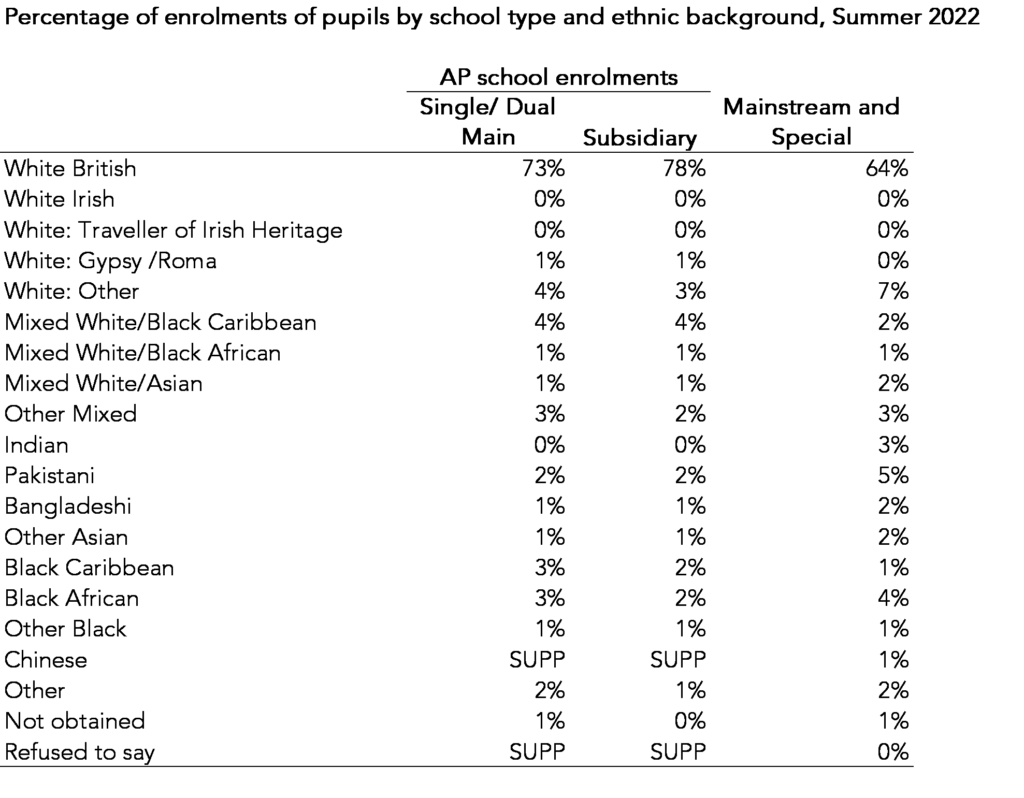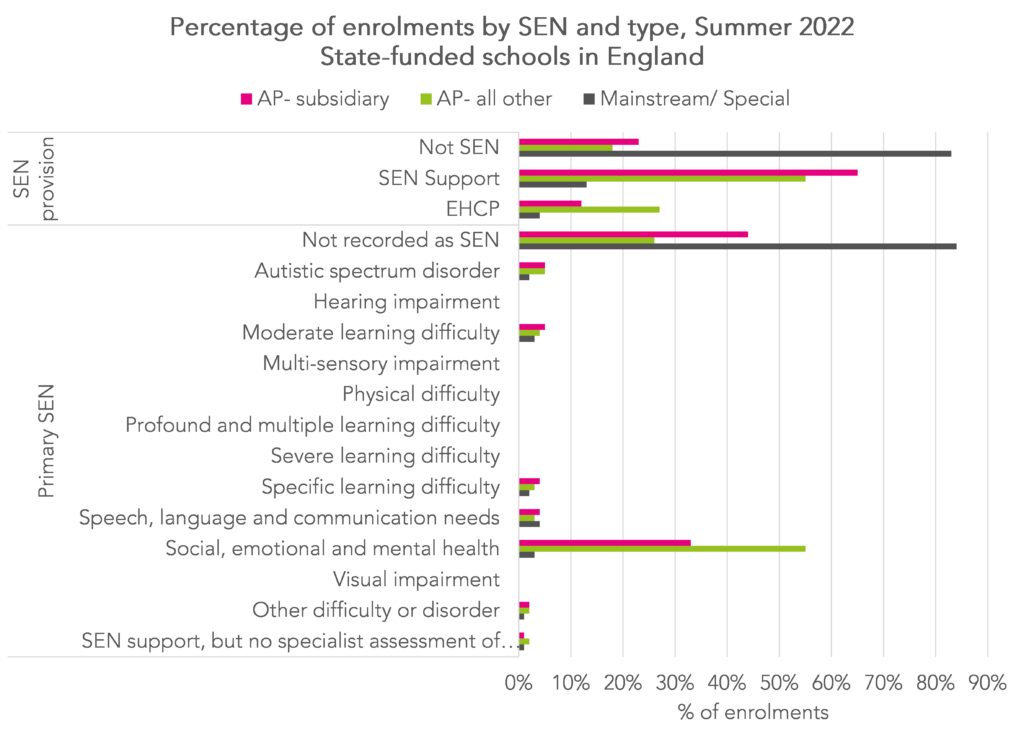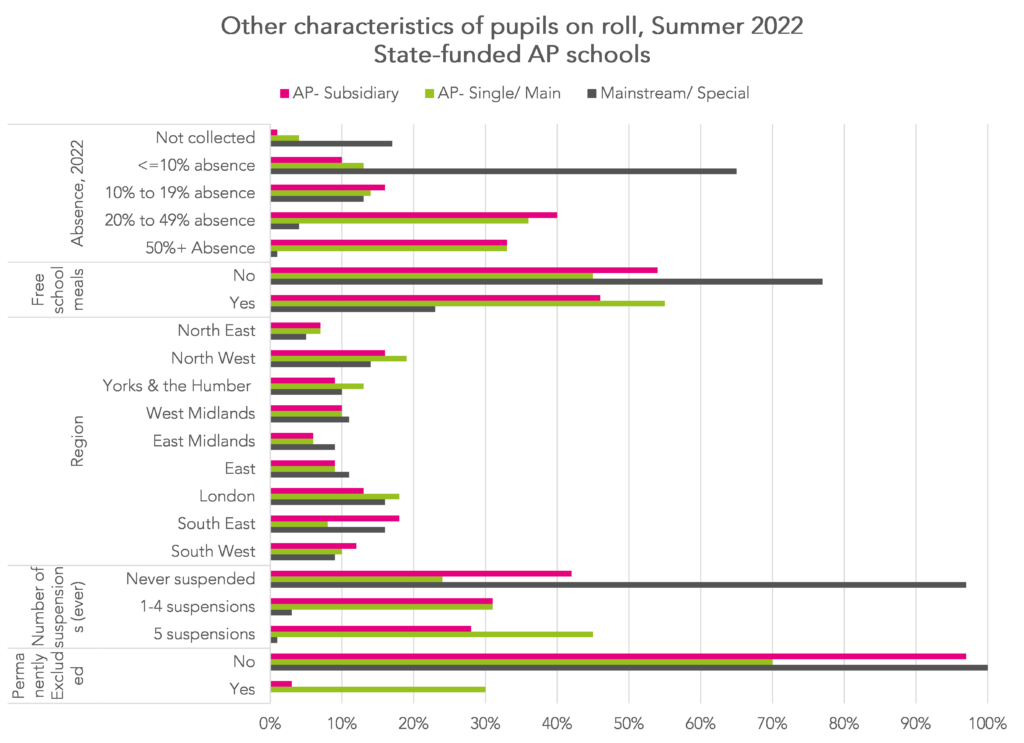In a recent blog, we showed how official statistics on numbers of pupils attending alternative provision schools are an under-estimate.
Briefly, statistics tend to ignore pupils with subsidiary registrations. In addition, statistics tend to be based on enrolments in January of each year. AP schools tend to “fill up” as the year progresses, with more pupils on roll in Summer than the rest of the year.
In this article, we examine the characteristics of pupils attending AP schools, comparing the 12,800 pupils with subsidiary registrations to 13,800 pupils with other types of registration.
Data
We use data from the Summer School Census in 2022 linked to data on pupils’ exclusion (and suspension) histories and their absence data from 2022.
This provides a record of each enrolment at each state-funded school in England in May 2022. Some pupils have more than one enrolment. In other words, there are more enrolments (8.49 million) than pupils (8.47 million).
We classify enrolments into three groups:
- State-funded AP subsidiary registration
- State-funded AP other registration (this includes single-registered and dual-main registered pupils)
- State-funded mainstream and special
In the sections that follow, we compare the characteristics of pupils in the three groups. Detailed tables, including school-level numbers of pupils, are included in the annex.
Age
Pupils on roll in state-funded AP schools, regardless of type of registration, tend to be older than the general school population, with 16 year olds being the modal age.
Subsidiary-registered AP pupils tend to be slightly younger than other pupils attending AP.
Ethnicity
In AP schools, 78% of subsidiary-registered pupils and 73% of other pupils are White British. This compares to 64% of the general school population although this latter figure would be higher if adjusted to reflect the age distribution of the AP sector.
There is disproportionality with respect to Black Caribbean and Mixed White/ Black Caribbean pupils. They are 2-3 times more likely to be enrolled at AP schools than the general population.
Gender
71% of pupils enrolled in AP schools with single/ dual main registrations are boys. This compares to 59% of subsidiary registrations (and 51% of the general school population).
In other words, there is greater gender balance among subsidiary-registered pupils.
Special Educational Needs
The vast majority of pupils enrolled in AP schools (82% of single/ main registrations and 77% of subsidiary registrations) were identified as having special educational needs (SEN).
The overwhelming majority in AP schools with SEN were identified as having social, emotional and mental health needs.
Other characteristics
The majority of pupils who attended AP schools were persistently absent in 2021/22. Around a third of pupils (both subsidiary and other registrations) were absent for 50% or more sessions.
The percentage of pupils attending AP schools who were eligible for free school meals (FSM) was more than double the rate of the general school population.
30% of pupils who attended AP schools with a single/ main registration had been permanently excluded at least once during their school career up to the end of 2021/22. This compares to just 3% of subsidiary registrations.
Subsidiary registered pupils were also less likely to have been suspended during their school career. 42% of subsidiary registered AP pupils had never been suspended compared to 24% of pupils with other types of registration.
Across the 9 regions of England, there tended to be fewer subsidiary registrations than single/ main registrations. The exceptions were the South West and, especially, the South East. In the latter, there were twice as many subsidiary registrations as single/ main registrations.
Pupils in Northern regions were more likely to be enrolled in AP schools than pupils elsewhere in the country. 39% of all single/main AP registrations were in schools in the North East, North West, and Yorkshire and the Humber, compared with only 29% of all mainstream / special enrolments.
Summing up
Pupils attending AP schools with subsidiary registrations share many similar characteristics compared with other pupils attending AP schools. They tend to be older than the general school population and more likely to be male, have special educational needs, be disadvantaged, be persistently absent and come from White British ethnic backgrounds.
However, those with subsidiary registrations are less likely to have been excluded or suspended during their school career.
Want to stay up-to-date with the latest research from FFT Education Datalab? Sign up to Datalab’s mailing list to get notifications about new blogposts, or to receive the team’s half-termly newsletter.











Leave A Comment